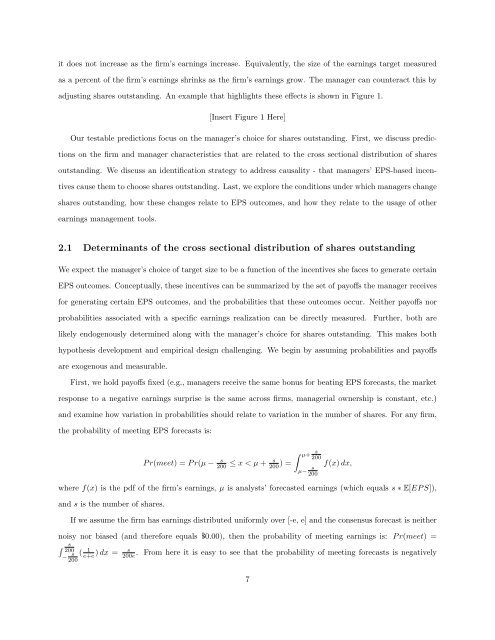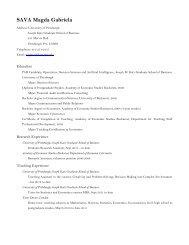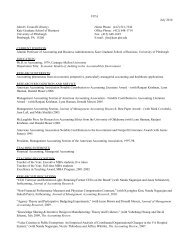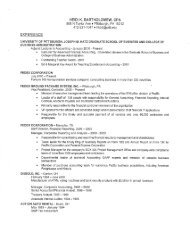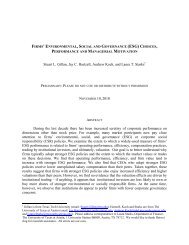Gaming the Float: How Managers Respond to EPS-based Incentives
Gaming the Float: How Managers Respond to EPS-based Incentives
Gaming the Float: How Managers Respond to EPS-based Incentives
You also want an ePaper? Increase the reach of your titles
YUMPU automatically turns print PDFs into web optimized ePapers that Google loves.
it does not increase as <strong>the</strong> firm’s earnings increase. Equivalently, <strong>the</strong> size of <strong>the</strong> earnings target measured<br />
as a percent of <strong>the</strong> firm’s earnings shrinks as <strong>the</strong> firm’s earnings grow. The manager can counteract this by<br />
adjusting shares outstanding. An example that highlights <strong>the</strong>se effects is shown in Figure 1.<br />
[Insert Figure 1 Here]<br />
Our testable predictions focus on <strong>the</strong> manager’s choice for shares outstanding. First, we discuss predictions<br />
on <strong>the</strong> firm and manager characteristics that are related <strong>to</strong> <strong>the</strong> cross sectional distribution of shares<br />
outstanding. We discuss an identification strategy <strong>to</strong> address causality - that managers’ <strong>EPS</strong>-<strong>based</strong> incentives<br />
cause <strong>the</strong>m <strong>to</strong> choose shares outstanding. Last, we explore <strong>the</strong> conditions under which managers change<br />
shares outstanding, how <strong>the</strong>se changes relate <strong>to</strong> <strong>EPS</strong> outcomes, and how <strong>the</strong>y relate <strong>to</strong> <strong>the</strong> usage of o<strong>the</strong>r<br />
earnings management <strong>to</strong>ols.<br />
2.1 Determinants of <strong>the</strong> cross sectional distribution of shares outstanding<br />
We expect <strong>the</strong> manager’s choice of target size <strong>to</strong> be a function of <strong>the</strong> incentives she faces <strong>to</strong> generate certain<br />
<strong>EPS</strong> outcomes. Conceptually, <strong>the</strong>se incentives can be summarized by <strong>the</strong> set of payoffs <strong>the</strong> manager receives<br />
for generating certain <strong>EPS</strong> outcomes, and <strong>the</strong> probabilities that <strong>the</strong>se outcomes occur. Nei<strong>the</strong>r payoffs nor<br />
probabilities associated with a specific earnings realization can be directly measured.<br />
Fur<strong>the</strong>r, both are<br />
likely endogenously determined along with <strong>the</strong> manager’s choice for shares outstanding. This makes both<br />
hypo<strong>the</strong>sis development and empirical design challenging. We begin by assuming probabilities and payoffs<br />
are exogenous and measurable.<br />
First, we hold payoffs fixed (e.g., managers receive <strong>the</strong> same bonus for beating <strong>EPS</strong> forecasts, <strong>the</strong> market<br />
response <strong>to</strong> a negative earnings surprise is <strong>the</strong> same across firms, managerial ownership is constant, etc.)<br />
and examine how variation in probabilities should relate <strong>to</strong> variation in <strong>the</strong> number of shares. For any firm,<br />
<strong>the</strong> probability of meeting <strong>EPS</strong> forecasts is:<br />
P r(meet) = P r(µ −<br />
∫ s µ+ s<br />
200 ≤ x < µ + s<br />
200 ) = 200<br />
µ− s<br />
200<br />
f(x) dx,<br />
where f(x) is <strong>the</strong> pdf of <strong>the</strong> firm’s earnings, µ is analysts’ forecasted earnings (which equals s ∗ E[EP S]),<br />
and s is <strong>the</strong> number of shares.<br />
If we assume <strong>the</strong> firm has earnings distributed uniformly over [-e, e] and <strong>the</strong> consensus forecast is nei<strong>the</strong>r<br />
noisy nor biased (and <strong>the</strong>refore equals $0.00), <strong>the</strong>n <strong>the</strong> probability of meeting earnings is: P r(meet) =<br />
∫ s<br />
200<br />
−<br />
s<br />
200<br />
( 1<br />
e+e ) dx =<br />
s<br />
200e<br />
. From here it is easy <strong>to</strong> see that <strong>the</strong> probability of meeting forecasts is negatively<br />
7


